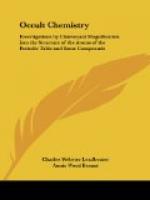The physical world is regarded as being composed of between sixty and seventy chemical elements, aggregated into an infinite variety of combinations. These combinations fall under the three main heads of solids, liquids and gases, the recognised substates of physical matter, with the theoretical ether scarcely admitted as material. Ether, to the scientist, is not a substate or even a state of matter, but is a something apart by itself. It would not be allowed that gold could be raised to the etheric condition as it might be to the liquid and gaseous; whereas the occultist knows that the gaseous is succeeded by the etheric, as the solid is succeeded by the liquid, and he knows also that the word “ether” covers four substates as distinct from each other as are the solids, liquids and gases, and that all chemical elements have their four etheric substates, the highest being common to all, and consisting of the ultimate physical atoms to which all elements are finally reducible. The chemical atom is regarded as the ultimate particle of any element, and is supposed to be indivisible and unable to exist in a free state. Mr. Crookes’ researches have led the more advanced chemists to regard the atoms as compound, as a more or less complex aggregation of protyle.
To astral vision ether is a visible thing, and is seen permeating all substances and encircling every particle. A “solid” body is a body composed of a vast number of particles suspended in ether, each vibrating backwards and forwards in a particular field at a high rate of velocity; the particles are attracted towards each other more strongly than they are attracted by external influences, and they “cohere,” or maintain towards each other a definite relation in space. Closer examination shows that the ether is not homogeneous but consists of particles of numerous kinds, differing in the aggregations of the minute bodies composing them; and a careful and more detailed method of analysis reveals that it has four distinct degrees, giving us, with the solid, liquid and gaseous, seven instead of four substates of matter in the physical world.
These four etheric substates will be best understood if the method be explained by which they were studied. This method consisted of taking what is called an atom of gas, and breaking it up time after time, until what proved to be the ultimate physical atom was reached, the breaking up of this last resulting in the production of astral, and no longer physical matter.
[Illustration]
It is, of course, impossible to convey by words the clear conceptions that are gained by direct vision of the objects of study, and the accompanying diagram—cleverly drawn from the description given by the investigators—is offered as a substitute, however poor, for the lacking vision of the readers. The horizontal lines separate from each other the seven substates of matter; solid, liquid, gas, ether 4, ether 3, ether 2, ether 1.




